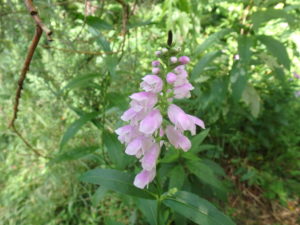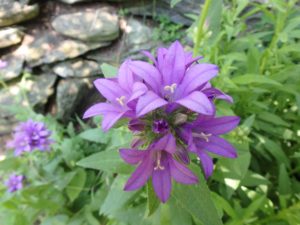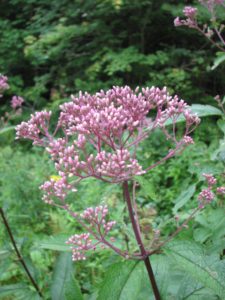Rambunctious Plants
“Some people are always grumbling because roses have thorns; I am thankful that thorns have roses.” That quote is from French journalist, novelist and critic Jean-Baptiste Alphonse Karr, who lived from 1808 to 1890.
He’s right of course, being thankful for the good attributes of flowers is important even though some also have some problematic traits. It would be easy to ban every flower that misbehaves. On this cold March day I can think of several problem-child flowers that I love.
Obedient Flower (Physostegia virginiana) certainly does not live up to its name: it is not at all well-behaved. I started growing it in a sunny spot with rich, moist soil. It grew to be 3 to 6 feet tall with square stems and lovely pink flowers in mid-July. But soon it wandered, taking over walkways and neighboring beds. It got into my rhubarb patch. It spread by root, and even a fragment left in the soil would come back.
Ultimately I hired a diligent young man who spent 10 hours or more just digging it out. “Take no prisoners,” I said. He did a good job by loosening the soil deeply with a garden fork, and then carefully teasing out the roots with a CobraHead weeder. The CobraHead is a single-tined hand tool that is fabulous for getting out roots.
Of course, given the beauty of the flowers and the fact that they have great vase-life, I had to re-plant a few of these non-obedient flowers. Where? Along the edges of a field that is partially shaded by willows, in an area with goldenrod and other tall, aggressive plants. I didn’t want to make life too easy for these beauties, and that worked. I can go pick stems for arrangements, and if the flowers want to spread I can mow them.
Another vigorous spreader is the Clustered Bellflower (Campanula glomerata). This is a lovely globe-shaped cluster of blossoms that are a bluish-purple on stems about 18 inches tall. Like obedient plant, it spreads by root and can be invasive if planted in full sun with rich moist soil. It showed up in my garden without ever being purchased. Some scrap of root must have come in with another flower, perhaps a gift plant.
But Clustered Bellflower is much easier to control than Obedient Plant. It digs easily, and I found that by putting it in drier, shadier locations made it a very nice addition to the garden.
Joe Pye Weed (Eupatorium purpureum) is a native wildflower that grows alongside my brook, flowering in August. I like the flowers even though they don’t last long in a vase. It’s great food for bees and butterflies. It can reach 6 feet or more tall and has many small pink-purple flowers growing in clusters. A related species, E. maculatum, is said to be a bit shorter and tidier, especially a named cultivar, ‘Gateway’. I bought Gateway and liked it – for several years. Then, like many of us, it spread in middle age. A tidy 2-foot wide plant became a messy 5-foot wide plant, tall and floppy. It had to go.
Digging up my Joe Pye was a real test of my mettle. No helper available, I went at it with a shovel and fork. It didn’t even wiggle. So I cut off all stems and went at the roots with a pick-ax. Three hours later I had removed the roots. Later I learned about a cultivar called ‘Little Joe’ of a related species, E. dubium. This one, I read, is a really nice size, maybe two feet tall and wide. But elsewhere I see it listed as 3 to 4 feet tall. Hmm. I need to be wary about these flowers. But I bet if I see one for sale, I’ll try it. Silly me.
Once I decided to try planting a true bamboo plant. I had been warned that bamboo can take over a garden, spreading by root. So to prevent that, I planted the bamboo in a 50-gallon plastic drum. First I drilled drainage holes in the bottom and buried it, leaving a 3 inch lip above the soil line. I filled it with great soil and compost. Silly me. The bamboo barely survived the first winter, and eventually succumbed. But better safe than sorry.
There are many plants that have been introduced to the United States with good intentions (or by mistake), only to turn invasive. Purple loosestrife is one, Japanese Knotweed is another. Neither is controlled by any native American insect pests and they spread like wildfire. Both have root systems that are daunting, and a mature purple loosestrife plant, I have read, can produce a million seeds or more. And those seeds last for years.
Fortunately, purple loosestrife, which can take over marshes and wet areas, is now being controlled by a beetle imported from Europe where the loosestrife comes from. The beetle was tested before being released and it was found to be species specific: it won’t eat your peonies or your tomatoes.
So what have I learned from my experiences? Don’t give rambunctious plants what they want. Give them less sun, less water and poor soil. Those are better places for overly enthusiastic plants. But also enjoy what they have to offer – and don’t focus on the thorns.
Reach Henry at P.O. Box 364, Cornish Flat, NH 03746 or henry.homeyer@comcast.net. Read his twice-weekly blog with lots of photos at https://dailyuv.com/gardeningg





